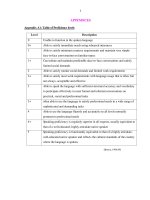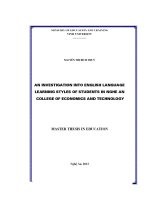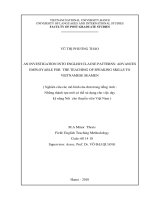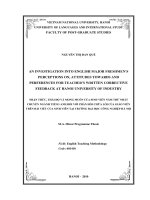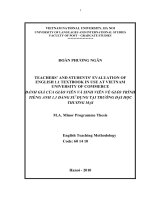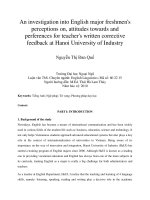An investigation into english learning styles of the 11th grade students and some suggested activities = nghiên cứu phong cách học tiếng anh của học sinh lớp 11 và một vài hoạt động gợi ý
Bạn đang xem bản rút gọn của tài liệu. Xem và tải ngay bản đầy đủ của tài liệu tại đây (273.09 KB, 49 trang )
Vinh University
Foreign language department
----------***----------
Ngun ThÞ Thanh Loan
An investigation into English learning styles
of the 11th grade students and some suggested
activities
(Nghiªn cøu phong cách học tiếng anh của học sinh lớp
11 và một vài hoạt động gợi ý)
Graduation thesis
Field: English Methodology
Vinh, 2009
Vinh University
Foreign language department
----------***----------
1
An investigation into English learning styles
of the 11th grade students and some suggested
activities
(Nghiên cứu phong cách học tiếng anh của học sinh lớp
11 và một vài hoạt động gợi ý)
Graduation thesis
Field: English Methodology
Supervisor: Nguyễn Thị Vân Lam
Student
: Nguyễn Thị Thanh Loan
Class
: 46A-English
Vinh, 2009
Acknowledgements
My graduation thesis has been completed with great support from my
teachers, friends and members of my family.
First of all, I would like to gratefully and respectfully acknowledge my
supervisor, Mrs. Nguyen Thi Van Lam (M.A) for her enormously useful advice,
constant and tirelessness helps and support when doing this thesis. Without her
help, this thesis would not have finished.
Additionally, I wish to express my deep gratitude to the foreign language
librarian who gives much useful help to get necessary materials for this thesis.
Also, I am really thankful for the enthusiastic participation of students and
teachers in Le Hong Phong High School who give me a great deal of help to
finish this thesis.
Finally, I am grateful to my dedicated friends and my beloved family who
give me a great deal of encouragement and useful advice during my studying
process.
Vinh, December, 25th 2008.
2
Abbreviations
FLA: First Language Acquisition
SLA: Second Language Learning
SLL: Second Language Learning
3
Lists of figures
Figure 2.1. Students and Their Interest in Leaning English............................ 17
Figure 2.2. Chart Showing Students and their Interest in Leaning English..... 18
Figure 2.3. Students’ Personalities................................................................. 18
Figure 2.4. Chart Showing Students’ Personalities ........................................ 19
Figure 2.5. Students’ Opinion about their Favorite Activities ....................... 19
Figure 2.6. Chart Showing Students’ Opinion about the Favorite Activities... 19
Figure 2.8. Students’ Ideas about the importance degree of learning styles
in English leaning success.............................................................................. 20
Figure 2.7. Students’ Opinion about the Importance of Learning Styles in
Target Language Leaning............................................................................... 21
Figure 2.9. Chart Showing Students’ Ideas about the Importance Degree of
Learning Styles in English Leaning Success...........
21
Figure 2.10. The Frequency Degree of Teacher’s Using Variety of
Activities in the Class...................................................................................... 22
Figure 2.11. Students’ Opinion about Teachers’ Teaching Styles................... 23
Figure 2.12. Chart Showing Students’ Opinion about Teachers’ Teaching
Styles............................................................................................................... 23
Figure 2.13. Students’ Satisfaction about Teacher’s Pedagogical Methods... 23
Figure 2.14. Chart Showing Students’ Satisfaction about Teacher’s
Pedagogical Methods...................................................................................... 24
Figure 2.15. Students’ Change in Learning Ways . ........................................ 24
Figure 2.16. Students' Understanding about Their Learning Styles .............. 25
Figure 2.17. Chart Shows Percentage of Students' Perceptual Learning
Styles............................................................................................................... 25
Figure 2.18. Percentage of Students' Perceptual Learning Styles.................. 25
Figure 2.19. Students' answers to questions about cognitive learning styles... 26
Figure 2.20. Types of Cognitive Learning styles........................................... 27
table of contents
Acknowledgements............................................................................I
Abbreviations.........................................................................................II
Lists of figures ......................................................................................III
Table of contents................................................................................Iv
Part I: Introduction...........................................................................................1
1. Reasons for Choosing the Topic..................................................................1
2. Aims of the Study........................................................................................1
3. Scope of the Study.......................................................................................2
4. Methods of the Study...................................................................................2
5. Design of the Study.....................................................................................2
4
Part II: DEVELOPMENT................................................................................3
Chapter 1: Theoretical Background.................................................................3
1.1. First and Second Language Learning:...................................................3
1.1.1. First and Second Language:................................................................3
1.1.2. Learning and Acquisition:.....................................................................3
1.1.3. First and Second Language Learning:...................................................3
1.1.3.1. Behaviourist:.......................................................................................3
1.1.3.2. Innatism:.............................................................................................4
1.1.3.3. Interactionist Position:........................................................................5
1.2. Factors Affecting Second Language Learning.........................................5
1.3. Learning Styles.........................................................................................6
1.3.1. Definition: .............................................................................................6
1.3.2. Classification.........................................................................................7
1.3.3. Factors affecting learning styles............................................................10
1.4. Application of Learning Styles into teaching English..............................11
1.5. Ways to Identify Students’ Learning Styles:............................................12
1.5.1. Observation:...........................................................................................12
1.5.2. Questionnaire:.......................................................................................13
1.5.3. Interview:...............................................................................................14
Chapter 2: Investigation into Students' Learning Styles in Le Hong
Phong High School- Nghe An.........................................................................15
2.1. Overview of the Survey:...........................................................................15
2.1.1. Aims of the Survey:...............................................................................15
2.1.2. Informant and Settings:..........................................................................15
2.2. Description of the Survey Questionnaires:...............................................16
2.2.1. Survey Questionnaires: .........................................................................16
2.2.2. Results and Findings:............................................................................17
Chapter 3: Suggestions for Teachers to Use Variety of Activities to
Agree Students’ Learning Style.......................................................................29
3.1. Preparation of Lesson Plans:....................................................................29
3.2. Suggestions of Some Appropriate Activities for Each Learner:...............30
3.2.1. For Visual learners:...............................................................................30
3.2.1.1. Using Visual Aids in Teaching:.........................................................30
3.2.1.2. Writing Story through Pictures...........................................................31
3.2.1.3. Remembering Words..........................................................................32
3.2.1.4. Movie – watching.............................................................................33
3.2.2. For Auditory learners: ..........................................................................34
3.2.2.1. Using Audio Aids:..............................................................................34
3.2.2.2. Story- telling:......................................................................................35
3.2.2.3. Using Music in Class:.........................................................................36
3.2.2.4. Listening in Motion:...........................................................................38
3.2.2.5. Repeating Hard Words:......................................................................39
3.2.3. For Kinesthetic Learner:........................................................................40
3.2.3.1. Using Visual Aids and Objects:.........................................................40
3.2.3.2. Role- playing:.....................................................................................40
3.2.3.3. Action Games:....................................................................................41
3.3. Suggestions for Students to Take Advantages of Their Strengths in
Learning English.............................................................................................42
3.3.1. For Visual Learner:...............................................................................43
3.3.3. For Kinesthetic Learners:......................................................................44
3.3.2. For Auditory Learners...........................................................................44
Part III : Conclusion.............................................................................45
Preference................................................................................................47
5
Appendix.....................................................................................................51
Part I: Introduction
1. Reasons for Choosing the Topic
Learning style is an important factor that affects to the second language
learning (SLL). In fact, many researchers and teachers seem to know of the
concept, and most of them find learning styles interesting and important.
However, there is little research that reveals about the relationship between
learning styles and success in English learning. Therefore, the author would
like to find out more information about learning styles and its application in
teaching English.
Moreover, the classroom teachers tend to ignore students’ learning styles
although they know that there are always many kinds of learning styles in a
class. Meanwhile each learner has his own way to learn and to process
information, teachers often only use the same methods to teach. This leads to
6
the low results in the teaching and learning process. Thus, the author would
like to present some suggestions that may be useful for teachers to adjust
these teaching styles so that they are suitable for students' learning styles.
Lastly, the author is being trained to be a teacher of English in the near
future. She is aware that knowing and catering to students’ learning styles can
help them a great deal to improve their English.
With all the reasons above, the author finds it interesting to conduct this
study entitled “An Investigation into English Learning Styles of the 11 th
grade students and Some Suggested Activities”....
2. Aims of the Study
The study aims at
- Investigating into learning styles and its benefits in second
language learning.
- Providing teachers, students with activities needed to satisfy
students’ learning styles in classroom
- Providing students with some clues for them to help
themselves in learning English.
3. Scope of the Study
In the limitation of a thesis, the author only wishes to help focus on
learning styles and the importance of learning styles, some suggestions for
students to help them to make use of their strengths and some clues for
teachers to satisfy students’ learning styles in classroom.
4. Methods of the Study
To complete this study, the following methods were employed:
- analytic and synthetic methods
- comparative and contrastive methods
- descriptive methods
Firstly, the author uses analytic and synthetic methods to review the
theories related to the matter in concerned to form a theoretical framework for
the analysis, collect books and materials, find and select necessary
information.
Then, the information received from the survey is analyzed and sorted to
make a clear distinction about students learning styles. The results are
arranged into categories for comparison.
Finally, descriptive methods are used to make a description about some
activities suitable for each learning styles.
7
5. Design of the Study
The thesis consists of three main parts: introduction, development and
conclusion
Part I: Introduction
This part includes five sub-parts: reasons, aims, scope, methods and design of
the study.
Part II: Development
This part consists of three chapters:
Chapter 1: Theoretical Background
In this chapter, the author reviews some aspects of theory that relate to
learning styles as a theoretical background for the study. The theories about
first and second language learning and factors affecting second language
learning are presented in the comparison with the first language learning.
Additionally, learning style's definitions and classifications are presented
form different points of view. The author also discusses the factors affecting
students' learning styles and ways to identify their learning styles.
Chapter 2: Investigation into Students' Learning Styles in Le Hong Phong
High School- Nghe An.
In this chapter, the results of a survey on students' learning styles in Le
Hong Phong High School are presented with some comments and anlysis. The
author describes the aims, informant and settings, survey questionnaires,
results and findings to make the clear understanding about students' learning
styles in high school.
Chapter 3: Suggested Teaching and Learning Activities for Different Learning
Styles
In this chapter, suggested activities for teachers are presented first to help
them accommodate students' learning styles at the classroom level.
Additionally, activities for students are discussed to help them make use of
their strengths in learning styles.
Part III: Conclusion
This part summarizes what has been discussed in the two parts above and
offers some suggestions for further studies.
8
Part 2: DEVELOPMENT
Chapter 1: Theoretical Background
1.2. First and Second Language Learning
1.2.1. First and Second Language
First language is the language that an individual learn first. First language is
also called native language or mother tongue.
Second language is defined as any language other than the first language in a
wide sense. In narrower sense, it is a language learned after the first language in
a context where the language is used widely in the speech community.
1.1.2. Learning and Acquisition
Learning is a conscious process of study and attention to form and rule
learning. The results of learning are the explicit knowledge about the form of a
language and the ability to verbalize this knowledge. In contrast, acquisition is
the natural way and this definition refers to an unconscious process that involves
through using language for meaningful communication.
According to Krashen (1982, cited in Nguyen Thi Van Lam and Ngo Dinh
Phuong 2007), acquisition is the more important process and he asserts that only
acquired language is readily available for natural, fluent communication. Further,
he claims that learning cannot turn into acquisition.
1.1.3. First and Second Language Learning
There have been three main theoretical approaches to explaining the relation
between first and second language learning: behaviorist, annatist and
interactionist approaches.
1.1.3.1. Behaviourist
Behaviorism is a psychological theory of learning which was very influential
in the 1940s and 1950s. Traditional behaviourists believed that language learning
is the result of imitation, practice, feedback on success and habit formation.
Behaviorism accounts for second language acquisition (SLA) with the same
theory as for first language acquisition (FLA). Behaviorists explain that the
process of learning first language as well as the second language can take place
through imitation, practice, reinforcement and habit formation. Language
development is viewed as the formation of habits formed in the first language
9
and these habits interfere with the new ones needed for the second language
(Lado 1964, cited in Nguyen Thi Van Lam and Ngo Dinh Phuong 2007).
Behaviourism was often linked to the Contrastive Analysis Hypothesis
(CAH) which was developed by structured linguists. The CAH predicts that
where there are similarities between the first language and the target language,
the learner will acquire target structures with ease and where there are
differences, the learner will have difficulties (Nguyen Thi Van Lam and Ngo
Dinh Phuong, 2007).
1.1.3.2. Innatism
The linguist Noam Chomsky claims that children are biologically
programmed for language and that language develops in the child in just the
same way that other biological functions develop. For Chomsky, language
acquisition is similar to the way the children learn to walk. The environment the availability of people who speak to the child - and the child's biological
endowment will do the rest. In Chomsky's writing, language acquisition is based
on the hypothesis that innate knowledge of the principles of Universal Grammar
(UG) permits all the children to acquire the language of their environment,
during a critical period in their development. According to Chomsky's theory, he
explains Universal Grammar as a set of principles that are common to all
languages and argues that the language acquisition device works successfully
only when it is stimulated at the right time called "Critical period".
Linguists working within innatist theory assume that the U.G offer the best
perspective from which to understand SLA. Krashen (1982, cited in Nguyen Thi
Van Lam and Ngo Dinh Phuong 2007) presented five hypotheses which
constitute what he calls the "Monitor Model" by origin: Acquisition- Learning
Hypothesis, Monitor Hypothesis, Natural Order Hypothesis, Input Hypothesis
and Effective Filter Hypothesis.
1.1.3.3. Interactionist Position
According to the Interactionist Position, language develops as a result of the
complex interplay between the uniquely human characteristics of the child and
the environment in which the child develops (Cited in the Nguyen Thi Van Lam
and Ngo Dinh Phuong, 2007). In the Interactionists' point of view, much second
language acquisition takes place through conversational interaction. Besides, Lex
Vygosky had the sociocutural theory of human mental processing which assumes
that language develops entirely from social interaction. He referred to the child's
10
zone of proximal development as what the child could do in interaction with
another.
In short, behaviorism can explain how some aspects of the language such as
word meanings and some language routines are learned. Innatism can account
for the complexity of the knowledge that all learners eventually attain.
Interactionists view that learners develop language through one-to-one
interaction.
1.2. Factors Affecting Second Language Learning
There are many factors that affect second language learning (SLL). Some of
them are intelligence, aptitude, personality, motivation, attitudes and learner
preferences (Nguyen Thi Van Lam and Ngo Dinh Phuong, 2007).
Intelligence is one of the factors which are related to success in SLL. The
term "intelligence”.. refers to performance on certain kinds of tests. The new way
of testing the relation between intelligence and second language learners’
success called IQ (intelligence quotient) came into being as a good means of
predicting the rate of success of language learners.
Aptitude is also a factor that has an effect on second language learning.
Aptitude is considered such as a special ability to learn a foreign language
quickly. It consists of different types of abilities such as to identify and
memorize new sounds, to understand the function of particular words in
sentences; how words function grammatically in sentences, to figure out
grammatical rules from language samples and memory for new words.
Personality is another factor believed to have many effects on the success
in learning. Some studies have found that success in language learning is
correlated with learner scores on characteristic often associated with extroversion
such as assertiveness and adventurousness; others have found that successful
learners do not get high score on measures of extroversion. Inhibition, selfesteem, empathy, dominance, talkativeness, and responsiveness are also factors
of personality affecting students’ leaning in some degrees.
Furthermore, motivation and positive attitudes are viewed to affect success
in SLL. The overall findings show that positive attitudes and motivation are
related to success in second language learning. There are two kinds of motivation
in learning; they are integrative motivation which refers to language learning for
personal growth and cultural enrichment and entrustment motivation for
language learning for more immediate or practical goals. Linguistics proves that
internal motivation is better than external motivation.
11
Additionally, learner preferences (learning styles and learner belief) exert an
effect on the process of second language learning. Learner beliefs are usually
based on previous learning experiences and the assumptions that a particular type
of instruction is the best way for them to learn. Learning styles are the ways
learners use to absorb, process and retain the new information. Learners’
preferences for learning will influence the kinds of strategies they use in order to
learn new material. The teacher can use this information to help leaners expand
their repertoire of learning strategies and thus develop greater flexibility in their
ways of approaching language learning.
1.3 Learning Styles
1.3.1. Definition
The layman’s understanding of learning styles is something like the way in
which you learn or the special strengths and tactics of the learner. These
definitions are very broad to be of any practical use.
According to Light Bown and Spada (1995, cited in Nguyen Thi Van Lam
and Ngo Dinh Phuong 2007), the term “learning styles”.. has been used to
describe an individual’s natural, habitual and preferred way of absorbing,
processing and retaining new information and skills. This definition is used
widely in academic.
For Dunn and Dunn (1978), learning styles is the way in which each
individual learner to begin to concentrate on, process, absorb and retain new and
difficult information. This seems similar to Light Bown and Spada’s definition.
Curry (1987) speaks of “individual differences in individual cognitive
approach and process of learning”.., Kolb (1984) defines it as “dialectic tension
between the apprehension and transformation dimensions”...
Mc Cathy (1987) defines learning style as “the combination of how we
perceive and how we process that forms the uniqueness of our learning styles,
our most comfortable way to learn.”..
Also, there are many researchers and scholar who have been trying to define
learning style and most of them focus on students’ ways to absorb, process and
retain new information.
1.3.2. Classification
According to Gardner (1993), there are eight types of learning styles:
Verbal (linguistic), logical (mathematic), visual (partial), bodily (kinesthetic),
musical (rhythmic), interpersonal, intrapersonal and naturalistic learning
styles.
12
Kolb (1984) classifies four major learning styles: imaginative learners,
analytic learners, common sense learners and dynamic learners. Imaginative
learners can perceive information concretely, process information by thinking
about it. They want to listen and share information to learn and need to
personally involve in and see all sides.
Analytic learners can perceive information abstractly and process
information by thinking about it. Furthermore, they need details and specific
ideas. They are also skilled verbally and often integrate their observation into
what they already know.
Common sense learners are those who perceive information abstractly.
The most prominent characteristic of this kind of the learners is that they
process information by doing it. They are problem solvers and are skills
oriented. They like to experiment and tinker with things. Common sense
learners need to know how things work and want to work on real problems.
They especially want to apply learning into real purposes.
Dynamic learners perceive information concretely. They also process
information by doing. They like changes and are risk-takers. They are not
sequential and like to pursue interests in diverse ways.
According to Light Bown and Spada (1999, cited in Nguyen Thi Van Lam
and Ngo Dinh Phuong 2007), there are two types of learning styles:
perceptual and cognitive learning styles.
Perceptual learning styles are based on perception-aware of directly
through any of the senses, especially sight or hearing. There are five subtypes
of perceptual learning styles. They are visual learners, auditory learners,
kinesthetic learners, tactile learners and haptic learners.
Visual learners prefer using images, pictures, colors and maps to organize
information and communicate with others. This kind of learner cannot learn
something well until they have seen it. Visual learners have a good spatial
sense, which gives them good sense of direction.
Kinesthetic learners learn more effectively through concrete body
experience or body movement. They often use their body and sense of touch
to learn about the world around. They like to think out issues, ideas and
problems while they exercise.
Auditory learners can learn effectively through the ears. They have good
sense of pitch and rhythm. Moreover, they can remember tunes and sound
patterns more easily than others.
13
Tactile learners can learn more effectively through touching. Tactile
learners are those who learn through experiencing or doing things. For this
reason, tactile learners may become bored more quickly than other students
while listening to a class lecture. Tactile learners like to experience the world
and act out events. To remember a phone number, tactile learners may remember
the pattern of their fingers as the press the numbers.
Haptic learners can learn more effectively through touching and body
movement, a combination of the kinesthetic and tactile styles. Haptic learning
refers to the sense of touch or grasp. These learners like a "hands on" approach to
learning, like to do artwork or doodle on notebooks, and succeed with tasks
requiring manipulation.
In cognitive learning styles, Light Bown and Spada (1999) divide them into
two subtypes: field-independent learners and field-dependent learners. Fieldindependent learners are more analytical, they can pick out hidden figures in a
complicated drawing more quickly. They tend to perceive elements
independently of a context or field and focus on details or see the details separate
from the background.
Field dependent learners are more relational and more inclined to see the
whole drawing and have difficulties separating it into parts. They tend to
perceive the whole field or situation and focus on general meaning. They see
things more holistically or generally.
Listed below are the principal characteristics of the two cognitive styles and
the implications of each for second language learning (Ellis, 1993).
Field independence
1. Impersonal orientation
i.e. reliance on internal frame of
reference in processing
information
Field dependence
1. Personal orientation
i.e. reliance on external frame of
reference in processing
information
2. Analytic
i.e. perceives a field in terms of its 2. Holistic
i.e. perceives field as a whole;
component parts; parts are
distinguished from background
parts are fused with background
3. Independent
i.e. sense of separate identity
3. Dependent
i.e. the self view is derived from
others
14
4. Socially sensitive
i.e. greater skill in
interpersonal/social relationships
4. Not so socially aware
i.e. less skilled in
interpersonal/social relationships
In the scope of a thesis, the author would like to deal with three main kinds
of perceptual learning styles (visual, auditory and kinesthetic ) and two main
kinds of cognitive learning styles (field-independent, field-dependent).
1.3.3. Factors Affecting Learning Styles
There are several factors that can influence a student’s learning styles. They
are environmental, personality, developmental and psychological factors.
The environment can affect all learning styles to some degree. Some students
achieve better in warm environments and others in cool environments (Hart,
1981). If the room is too hot or too cold, or if there is outside noise making it
difficult to concentrate or hear, all learning will be affected. However, some
learners may be more affected than others. Other environmental factors that may
affect learning include furniture or design. Some people prefer studying in a
wooden, plastic, or steel chair, but others become so uncomfortable in
conventional classroom seats that they are prevented from learning.
A student’s personality can also have some bearing on his or her preferred
learning style. A normally outgoing person may need to engage in group
activities so that they feel they have a chance to discuss the learning. More
reserved people may resist group activities and prefer to work alone. Therefore,
students’ own emotion may also affect their ability to learn.
One of the most important things to understand about learning styles is that
they are developmental in nature. Your learning style changes over time, based
on your experiences and your level of education. This is a natural process, so
people who have been out of school for some time may be surprised to find that
they do not learn the same way they remember learning before.
Sociological factors may also affect learning. Teachers need to be aware of
the students’ learning styles under various conditions. Variations that enhance,
or inhibit, learning may include learning alone, in pairs, in small groups, as part
of a team, with either an authoritative or a collegial adult, and wanting variety as
opposed to patterns and routines (Dunn and Dunn, 1993).
Physiological characteristics are another factor that can affect students'
learning. These characteristics refer to when and how students learn best.
15
Understanding students’ physiological characteristics is an effective way for
teachers to help students learn based on their perceptual strengths. The
characteristics include time of day, outside stimulation, energy level, and
mobility while studying. Some like to eat, chew gum, or drink while learning.
Some older students may even prefer to smoke while learning. Still other
students may have perceptual strengths in the area of energy level or mobility.
They may study better or work better in a classroom situation if they can move
around while learning and not be confined to one desk space (Dunn and Dunn,
1993).
1.4. Application of Learning Styles into Teaching English
Learner’s preferences for learning, whether due to their learning styles or
their belief about how languages are learned will influence the kinds of strategies
they choose to learn new materials. Teachers can use this information to help
their learners to expand their repertoire of learning strategies and thus develop
greater flexibility in their ways of approaching language learning. Students not
only can identify preferred learning styles, but students can score higher on tests,
have better attitudes, and are more efficient if they are taught in ways to which
they can more easily relate. Therefore, it is an advantage that the teacher should
take of to teach students in their preferred styles.
Even though learning styles will differ among students in the classroom, the
teacher should try to make changes in their classroom that will be beneficial to
every learning style. Some of these changes include room redesign, the
development of small group technique, preparation of lesson plans, appropriate
activities for each learner. etc.
One of the key factors for students in having acknowledge of their learning
styles is improved self-esteem (Martin and Potter, 1998). “Now these at-risk
students exhibit confidence and accept responsibility for their own learning”..
(Perrin, 1990, p.24). When they are willing to struggle to learn, they can be more
in control of their environment and ask for what they need (Martin and Potter,
1998).
Many believe that “schools should spend more time developing students’
awareness of their styles rather than pushing teachers into more in service
workshops”.. about adapting curriculum (O’ Brien, 1989, p.85). When students
understand their learning styles, they no longer feel different because they
require total quiet to study. Meanwhile others involve in activities actively.
16
Dunn (1993) claims that “students can learn almost any subject matter”..
when they are taught with methods and approaches responsive to their learning
styles strengths; these same students fail when they are taught in an instructional
style dissonant with their strengths.
1.5. Ways to Identify Students’ Learning Styles
There are many ways to identify students’ learning styles. Below the author
would like to present three most popular ways for teachers to apply at the class
level. They are observation, interview and questionnaires.
1.5.1. Observation
This technique is one of the simplest ways to identify students' learning
styles. It is easy to apply in class environment or at home environment. Teachers
or researchers can observe students' behaviors or their preferences in learning to
identify students' learning styles. The advantage of this method is the
convenience to find out the characteristics of each learner. Furthermore, this
method can be used to partly contribute students’ learning styles by their
observable behaviors. For instance, visual learners often draw, they like to take
things apart or build things. They enjoy puzzles, doodle. They like to detail
things and have a good sense of parts to the whole and remember places by
descriptions or images. Kinesthetic learners have a good sense of balance. They
are graceful in movement. They have tendency to solve the problem through
doing and use gestures. They feel ease in manipulating objects and especially
good at physical activities. Auditory learners are often sensitive to sound and
have good sense of pitch. They are good at remembering tunes and sound
patterns.
However, this method is limited in observable behaviors and it is rather
difficult to make exact statistics of students’ learning styles.
1.5.2. Interview
Interview is an oral examination between a reporter or questioner and students
aiming to find out students’ reference in learning English. There are many kinds
of interview to identify students’ learning styles. Teachers can interview each of
individual (one by one student) or groups of students. However, the teacher
always has to make a good preparation with a lot of questions rounding the topic.
One of the advantages of interview is that the teacher could acknowledge about
students’ belief and attitudes about the matter. Interview helps teachers have a
total look about students’ characteristics and preferences. In an interview, the
teachers also can observe students’ behaviors and listen to their opinions.
17
Therefore, it is easy for teachers to apply both observable behaviors and their
words into the identification.
In an interview, teachers depend partly on students’ utterances to identify
their learning styles because each learner often has different ways to express
their ideas. Visual learners often express their point of view by the phrases: “As I
can see”.., “let’s look at differences”.., “I cannot quite picture it”.., “see how this
works for you”.., “let’s draw a map ", etc. Kinesthetic learners often say “that feel
right to me”.., “I have a good feeling about this”.., etc. Auditory learners speak of
“that sounds right”.., “tune into what I am saying”.., etc. However, this way of
assessment is limited in a small number of students. It takes a very long time to
investigate in the larger scope.
1.5.3. Questionnaire
Using a questionnaire in the survey is the third way of learning styles
identification. In this way, the teacher uses a questionnaire including a certain
number of questions relating to learning styles. Using a questionnaire, the
teacher can test and identify learning styles accurately (Beaty, 1986). For
instance, it is difficult to determine whether a students’ hyperactivity is due to a
need for mobility, an informal setting arrangement, kinesthetic resources or a
lack of disciplines. A questionnaire is a reliable and valid entrustment and only
comprehensive one that can diagnose many learning styles traits that influence
individuals. (Shaughnessy, 1998).
One of the advantages of learning styles questionnaire is that it can assess the
rate of different learning styles in a vast number of students. It gets information
accurately and simultaneously. The analysis of the received information is also
easier than interview and observation. This way helps the teacher to collect even
students’ attitudes and beliefs. There are many researchers’ questionnaires which
teachers can use to identify learners’ learning styles. They are VAK survey
(Visual, Auditory, Kinesthetic), VARK survey (Visual, Auditory, Reading,
Kinesthetic), Barbara Fretz’s Model or Ray Barsch’s Model, etc. (Martin and
Potter, 1998).
Observation, interview and questionnaire are the most popular ways for the
teacher to assess students’ learning styles at class level. Each way has its own
benefits and difficulties. The teacher should choose the sutable technique due to
his aims and the scope of the identification. Also, the teacher can use three
techniques stimultaneously to get the highest results.
18
To investigate English learning styles of students in Le Hong Phong High
School, the author uses the third technique – questionnaire because of its
accuracy and popularity.
Chapter 2: Investigation into students' learning
styles in Le Hong Phong high school- Nghe An.
2.1. Overview of the Survey
2.1.1. Aims of the Survey
Students' learning style has been considered one of the important factors
affecting the learner's success in learning English. Teachers' profound
understanding about students' learning styles is the basis to promote learner's
results. Thus, it is essential to get hold of students' preferences or more
specifically their learning styles. Students’ learning styles may be different from
one another despite the fact that they are taught by the same teachers and the
same methods. Although the survey occurs in the scope of students in class level,
the survey will partly point out the facts about the application of learning styles
in learning English and the differences in the proportions of students' learning
styles in high school.
2.1.2. Informant and Settings:
After her teaching practice at Le Hong Phong High School, the author
collects some information about English teaching and learning here. There are
six teachers of English, most of whom are still young (30- 35 years old) and
responsible for their teaching. There is only one teacher who passed the English
teaching test in choosing excellent teachers of Nghe An province in 2009.
There are three grades 10, 11 and 12 with 27 classes in Le Hong Phong High
School in the school year 2008-2009. All of students are studying the new
English textbooks. Students in Le Hong Phong High School are not quite good at
learning English. There is only one 12th grade class learning the textbook
English 12 (advanced). However, the result of English learning in this class is
not very high. There has been no excellent English student over the past few
years.
Grade 11 is considered to learn at the normal level in comparison with grade
10 and 12. The objectives of the survey are two classes 11A1 and 11A2 that are
acknowledged to be two best 11th grade classes in leaning English. Having
19
chances to practice teaching English in theses classes, the author finds that
students here are quite interested in leaning English. In fact, they are specialized
in Math, Physics, Biology and Chemistry. However, they still pay attention to
learning English. The survey questionnaire was conducted among quite a large
number of the students in these classes to investigate their learning styles.
- Objects: 95 students from two classes of 11A1 and 11A2 in Le Hong
Phong High School
- The form of carrying out the survey: using questionnaires and analysis the
data.
- Time: 7h
- Date: March, 28th 2009
- Place: Le Hong Phong High School, Hung Nguyen town, Nghe An
province
- Number of participant: 95.
2.2. Description of the Survey Questionnaire
2.2.1. Survey Questionnaires
Two questionnaires with thirty questions are used in the survey. The first
questionnaire is about learner’s background and the aspects relating to the
students’ learning styles. In the second questionnaire, the author would like to
identify students’ learning styles by getting them to answer 15 questions.
The first questionnaire including 15 questions helps make a clear and full
understanding about students’ background, ideas and their preferred styles.
Question 1 reveals about how much time the students have been learning English
for. Question 2 shows us students’ interest in learning English. Question 3
enables the author to analyze students’ personalities. Question 4 shows the
information about students’ most favorite activities in class. Question 5 and 6
reveal about students’ ideas on the role of learning styles in the success of target
language learning. Question 7 estimates the frequency degree of the teacher’s
using variety of activities in the class. Questions 8 and 9 indicate students’
satisfaction about teaching styles. Question 10 enables us to know how often
students change their leaning ways. Questions 11, 12 and 13 are the basis for the
author to classify students into field dependent and field independent learners.
Question 14 shows students’ understanding about their learning styles. Finally,
question 15 reveals about students’ results in leaning in the last term.
20

